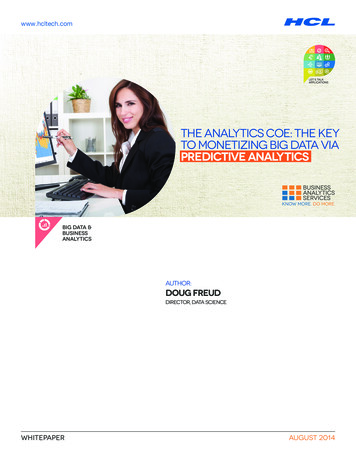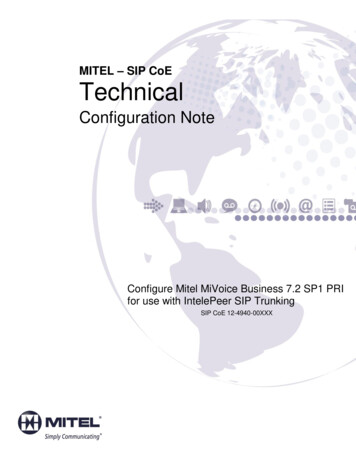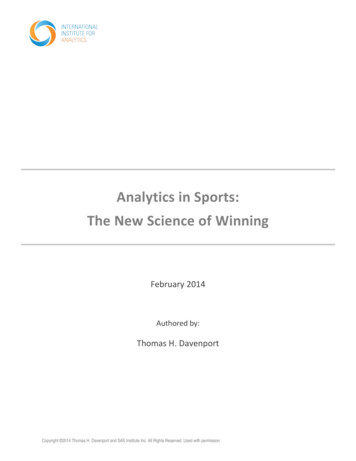
Transcription
www.hcltech.comThe Analytics COE: the keyto Monetizing Big Data viaPredictive Analyticsbig data &businessanalyticsAuthOr:Doug FreudDirector, Data ScienceWHITEPAPERAUGUST 2014
THE ANALYTICS COE: THE KEY TO MONETIZING BIG DATA VIA PREDICTIVE ANALYTICS AUGUST 2014In early 2012 Ann Winblad, the legendary investor and senior partner at HummerWinblad, was asked on CNBC’s Squawk box what is the new big thing. Her response:“Data is the new oil”. She pointed out that the data alone is not in of itself valuable,and that technologies that add value around big data as the new hot spot for ventureinvesting. Data is like crude. There are certainly companies that buy crude, but there isa significantly bigger market once the crude is refined into gasoline. The analogy holdstrue for data. Selling big data has little value, but if one can add insight via analyticsthen we have the opportunity to monetize it. There is a sea change in the corporateworld, and IT organizations can seize upon the opportunity to reinvent themselvesand transform from a support function into a profit center.What has changed?There are really 2 things that have changed, and created a very different mind-set. Thefirst is that Hadoop has revolutionized the way that most companies are thinking aboutmanaging data. The cost of managing data with expensive relational based systems hasdropped by orders of magnitude using No SQL based systems. In addition, one caneven use Open Source Hadoop, and only pay for the hardware. Data that was eitherarchived or thrown away can now be stored and managed with increasing flexibilityand at a price point that is significantly more tolerable. While this is an importantdevelopment the sea change is that the C level is now asking themselves can weimprove customer experience by analyzing this data or are there secondary uses for thisdata (i.e. using it for something other than the original purpose for collecting it). Thesecondary purposes can include selling insight to third parties meaning IT can nowbe its own profit center. Ten years ago if someone wanted to store a new data domaininto the EDW the IT organization would ask for a business case. Today the mindsetappears to be store it, and we will figure out at a later date how we can monetize it.While there is a remarkable opportunity there are also many significant challengesthat organizations will have to overcome before being able to monetize big data. Therelational dB world is never going away, and still is the best approach for performingthe basic blocking and tackling that most organizations need to run their business. TheNo SQL market is immature, and it will be a while before the winners emerge. As ifNo SQL market is not confusing enough there are other important data managementtechnology trends like in memory platforms and graph based dB that are also gainingmomentum. In short the IT organization will need to invest in skills and technologyaround managing big data if they want to transform themselves into a profit center.In addition, IT will need to help analysts figure out how to work with both big datastored in No SQL systems combined with data stored in their current EDWs. Whilethis is in itself a significant challenge it is certainly not the only issue. Storing andmanaging data is a necessary condition, but in order to monetize big data analytics isrequired to refine it into something that adds value.The Predictive ChallengesAs if the new world of managing big data is not complicated enough there are otherconsiderations specific to predictive analytics that are problematic with respectto big data. These include a severe shortage of data scientists, what we used to callstatisticians, who are capable or experienced in building predictive models. Late lastyear McKinsey pointed out the key to being competitive is the ability to analyze big 2014, HCL TECHNOLOGIES. REPRODUCTION PROHIBITED. THIS DOCUMENT IS PROTECTED UNDER COPYRIGHT BY THE AUTHOR, ALL RIGHTS RESERVED.2
THE ANALYTICS COE: THE KEY TO MONETIZING BIG DATA VIA PREDICTIVE ANALYTICS AUGUST 2014data, but estimates that in the 2014 US alone there is a shortage of 175,000 datascientists and 1.5 million managers or analysts who know how to make decisions basedon the analytics. The shortage of analytical skills will not disappear quickly, and whileoffshoring and outsourcing can relieve some of the issues most senior managementunderstands that long term it must build these competencies in house if they reallywant to monetize big data. In addition to the shortage of human talent is that theanalytical tools that corporations use for predictive analytics are in a state of flux.The major players in this market SAS, IBM (SPSS), are now being joined by SAP(KXEN acquisition) and Oracle with interesting capabilities. In addition there isdisruption via Open Source languages like R and Python both of which are gainingincreasing traction. University students are increasingly cutting their teeth on opensource languages, and while there are undeniable advantages to these open sourceapproaches there is a limited population of people who ever become truly proficientin writing code. While the low or no cost approach of open source is at first glanceappealing the lack of a sufficient supply of data scientists will cause organizations tolook at solutions from the major vendors especially ones that will scale across Hadoopinfrastructure or in memory platforms like Hana that are ideal for solving real-timechallenges. In short there is a significant opportunity to monetize big data, but thereare some substantive challenges and investments that companies must make if theywant transform big data into insight or revenue.A Journey of a Thousand Miles begins with a first step: An IT basedAnalytics Center of ExcellenceAccording to Wikipedia, “a center of excellence refers to a team, a shared facility or anentity that provides leadership, evangelization, best practices, research, support and/or training for a focus area.” The key to monetizing Big Data via Predictive Analyticsis for IT to build an Analytics COE that understands the needs and challenges ofthe data scientist. The IT organization will be in the best position to understand thechallenges associated with a fast moving Data Management landscape, and how tocreate an ecosystem that scales. If each individual line of business tries to do this ontheir own they are unlikely to succeed. The organization needs to make a commitmentto developing the proper infrastructure, and the way to start this is with a well-fundedand empowered COE.The COE can’t solve the shortage of data scientists, but can help out in the followingways:yy Create an environment and collaborative community that attracts Data Scientists.The best Data Scientists are most interested in building and deploying predictivemodels. If there is no community or a perceived lack of investment it will bedifficult to attract and or retain Data Scientists. Data Scientists are not interestedin doing everything themselves. They want and need a scalable, collaborative, andflexible infrastructure that only IT can supportyy Invest in tools that enable Business Analysts to build predictive models. Sincethere is a shortage of Data Scientists IT needs to find the tools and infrastructurethat empowers traditional business analysts with the ability to build predictivemodels. Numerous vendors are working on solutions that will work with BigData, and the analytics COE should be involved in the identification, selection, 2014, HCL TECHNOLOGIES. REPRODUCTION PROHIBITED. THIS DOCUMENT IS PROTECTED UNDER COPYRIGHT BY THE AUTHOR, ALL RIGHTS RESERVED.3
THE ANALYTICS COE: THE KEY TO MONETIZING BIG DATA VIA PREDICTIVE ANALYTICS AUGUST 2014and implementation of these tools. Investment in such solutions will provide acompelling career path for traditional business analysts, and these tools should alsobe made available to third parties (e.g. consultants and system integrators). TheCOE should use these tools to create a Self-Serve Predictive capability. It is only amatter of time before clever vendors implement a semantic layer for creating theanalytical data set, which is almost always the most difficult part of building andeventually deploying predictive modelsWithout an internal Analytics based COE an organization is unlikely to have thewherewithal, expertise, or momentum to monetize big data. IT typically investssignificant resources around the EDW in support of BI and traditional analyticswithout understanding that the needs of the Data Scientist are fundamentallydifferent. The end result is that the clever data scientist finds the EDW staging areaand removes the data before it is rendered unusable into an environment that doesnot scale. In order to get their jobs done the Data Scientists create their own shadowIT, and there is a convoluted set of processes that often involve third party suppliers(e.g. Marketing Service Providers) in order to deploy. While this approach might workfor a support function like marketing campaigns it is destined to fail if the results ofpredictive analytics are itself the product.How HCL can help?HCL’s Business Analytics Services is a leader in advanced analytics and businessintelligence with an Analytics Center of Excellence consisting of 50 data scientistsand analysts with advanced degrees in applied statistics. The Analytics COE providesexpert implementation services:yy Architecture Assessmentyy Model and Rule Developmentyy Strategy and Roadmapyy Model Deployment and Integrationyy Tool Evaluationyy Maintenance and Enhancement Servicesyy Architecture and Designyy Advanced VisualizationFor more information, please contact HCL at ets.bis@hcl.com.HCL EXECUTIVE BIOGRAPHYDOUG FREUDDirector, Data ScienceDoug has over eighteen years of enterprise application development, sales, marketingand professional services experience.Doug is an expert at helping large organizations change their business processes inorder to make “data” based decisions. He has extensive experience implementingChurn, Cross-Sell/Upsell, and Propensity models. 2014, HCL TECHNOLOGIES. REPRODUCTION PROHIBITED. THIS DOCUMENT IS PROTECTED UNDER COPYRIGHT BY THE AUTHOR, ALL RIGHTS RESERVED.4
ABOUT HCLAbout HCL TechnologiesHCL Technologies is a leading global IT services company working with clients in theareas that impact and redefine the core of their businesses. Since its emergence on theglobal landscape, and after its IPO in 1999, HCL has focused on ‘transformationaloutsourcing’, underlined by innovation and value creation, offering an integratedportfolio of services including software-led IT solutions, remote infrastructuremanagement, engineering and R&D services and business services. HCL leveragesits extensive global offshore infrastructure and network of offices in 31 countries toprovide holistic, multi-service delivery in key industry verticals including FinancialServices, Manufacturing, Consumer Services, Public Services and Healthcare &Life Sciences. HCL takes pride in its philosophy of ‘Employees First, CustomersSecond’ which empowers its 91,691 transformers to create real value for customers.HCL Technologies, along with its subsidiaries, had consolidated revenues ofUS 5.4 billion, for the Financial Year ended as on 30th June 2014. For more information,please visit www.hcltech.comAbout HCL EnterpriseHCL is a 6.5 billion leading global technology and IT enterprise comprisingtwo companies listed in India – HCL Technologies and HCL Infosystems.Founded in 1976, HCL is one of India’s original IT garage start-ups. A pioneerof modern computing, HCL is a global transformational enterprise today. Itsrange of offerings includes product engineering, custom & package applications,BPO, IT infrastructure services, IT hardware, systems integration, anddistribution of information and communications technology (ICT) productsacross a wide range of focused industry verticals. The HCL team consists of over95,000 professionals of diverse nationalities, who operate from 31 countriesincluding over 505 points of presence in India. HCL has partnerships withseveral leading global 1000 firms, including leading IT and technology firms.For more information, please visit www.hcl.comHello there! I am an Ideapreneur. I believe that sustainable business outcomes are driven by relationships nurtured throughvalues like trust, transparency and flexibility. I respect the contract, but believe in going beyond through collaboration,applied innovation and new generation partnership models that put your interest above everything else. Right now 95,000Ideapreneurs are in a Relationship Beyond the Contract with 500 customers in 31 countries. How can I help you?
THE ANALYTICS COE THE E TO MOETIIG BIG DATA IA PREDICTIVE ANALYTICS AUGUST 2014 2014, HCL TECHNOLOIES. REPRODUCTION PROHIBITED. THIS DOCUMENT IS PROTECTED UNDER COPYRIHT BY THE AUTHOR, ALL RIHTS RESERVED. 3 data, but estimates that










